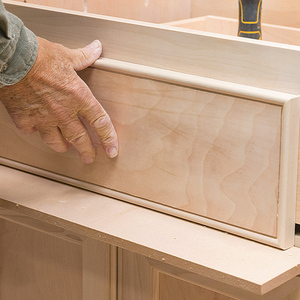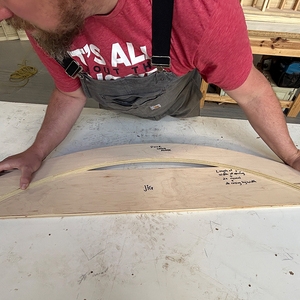In the interest of not tearing up my siding, I want to attach a ledger “beam” to the poured concrete foundation of my home. Plan is to attach doubled 2X12s (with spacers to allow drainage), to the concrete with bolts into concrete (3/4 of 1/2 depending on final load analysis). This beam would sit just below the siding. The 2X12 framing would be set on TOP of the ledger, in the same way it will ride over the beams set out away from the house. This places the finished surface exactly at the right level. The question is: What is the best way to attach the deck framing to the ledger beam? I need to stop any lateral movement as well as uplift.
Edited 10/20/2007 10:10 am ET by Poolman



















Replies
I would be inclined to draw up a simple welded steel bracket instead of using wood sandwiched and stacked. Bracket would bolt to the wall and then have a riser of some sort to support the ledger. I can imagine numerous ways of doing this. If you want to use wood as described, you could simply stack the rim joist directly on top of the ledger and use Simpson tie plate to connect them.
Thought about steel, perhaps a squared off Z shaped bracket with a small brace at 45 degrees under the horizontal section. 3 bolts into concrete, 2 bolts thru wood and bracket? Just set rim joist into it and secure. Sounds strong, will prob. need an engineers seal, but thats not an issue.
With wood, use the Simpson "mending plates" or the diamond shape beam to joist connectors or both?
I am a fan of building so it will never require future repairs beacuse of initial construction issues. 110%untill the circumstances change, my answer will remain the same...
There's no such thing as 110%. When you sandwich the ledger, even with space, there is a place for moisture to live. When you stack the rim on top of it there's another. I would be going to the welder's myself, but that might be because I use one regularly and can get whatever I need easily and reasonably. I could send a fax with a hand-drawn sketch and pick up the brackets a few days later.
Agreed. In my world the fewer elements, joints, fasteners etc required to execute a project, the better. Eliminating a sandwched/built up support member in favor of the steel bracket seems like the better long range solution.
Now off to draw...
Thanksuntill the circumstances change, my answer will remain the same...
bump
for more ideas
One that I do sometimes is to hanger a beam perpendicular to the house wall on the concrete, then run the joists over it.
Welcome to the Taunton University of Knowledge FHB Campus at Breaktime. where ... Excellence is its own reward!
You could always support the deck near the house with posts and have no attachment to the house. That would eliminate the ledger issue with moisture as well as the stepped up ledger attached with steel or whateverf you choose.
I agree, but the goal is to have as few posts as possible, esp. close to the house as the area unde will be used as a patio area, the deck underside will be 8'6" up, so it's a really great space that we want to keep as open as possible.
Thanksuntill the circumstances change, my answer will remain the same...
Fingers has the best idea--build a freestanding deck, close to the house. Add knee braces to prevent lateral movement.
Would these work?
http://www.strongtie.com/products/categories/seismic_hurricane.html
If I rest the rim joist on the ledger those make sense, they are spec'd wher the joists ride over the outer beam.
Thanksuntill the circumstances change, my answer will remain the same...
Can you get away with 1-1/2" bearing? If not, run the joists full bearing with no rimboard and use blocking instead.Joe Carola
I will run the question thru the engineer loking at a couple other items on the job. That section of the deck will be 18 ft wide(edge joining house) and 19 feet deep. If I were hanging this on a traditional ledger, the joists would be bearing on the hangers only. If I set the joists on a beam bolted to the wall I could use blocking as you suggest and increase (double to 3") the bearing surface at the house.
More suggestions welcome!
Thanksuntill the circumstances change, my answer will remain the same...
Check out Fairfax County, VA's building department website. They have details for attaching a ledger to concrete walls.
I would hesitate to take your approach of setting the joists atop the ledger, however. Decks rely on the attachment of the joists to the ledger, and the ledger to the house, so that they don't pull away from the house. Your detail puts this lateral load on the toenails holding the joists to the ledger. Unless I missed a discussion of some sort of additional attachment, this concernms me.
Andy
"Never try to teach a pig to sing. It wastes your time and annoys the pig." Robert A. Heinlein (or maybe Mark Twain)
"Get off your dead #### and on your dying feet." Mom
"Everything not forbidden is compulsory." T.H. White, The Book of Merlin
Oh, lovely Fairfax... Moved our office from Fairfax to Loudoun. More space, parking etc. I will look at their web site. The project is in Frederick MD, but good details are always good to study.
I was going to find you at JLC and ask there
Thanksuntill the circumstances change, my answer will remain the same...
I don't hang out at the forurms much, there or here. I do respond to email, though. Mostly.
Fairfax County has great illustrations on their website. I base drawings on their stuff all the time. Andy
"Never try to teach a pig to sing. It wastes your time and annoys the pig." Robert A. Heinlein (or maybe Mark Twain)
"Get off your dead #### and on your dying feet." Mom
"Everything not forbidden is compulsory." T.H. White, The Book of Merlin
" I do respond to email, though. Mostly."Especially with the subject line, "Decks"
Eh?
Welcome to the Taunton University of Knowledge FHB Campus at Breaktime. where ... Excellence is its own reward!
"PayPal deposit" gets my attention faster. <G>Andy
"Never try to teach a pig to sing. It wastes your time and annoys the pig." Robert A. Heinlein (or maybe Mark Twain)
"Get off your dead #### and on your dying feet." Mom
"Everything not forbidden is compulsory." T.H. White, The Book of Merlin